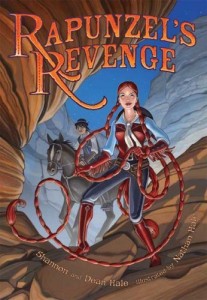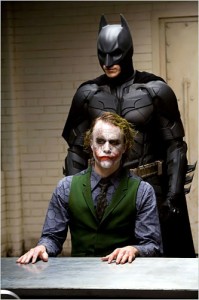 Recently, Shannon Hale wrote a blog entry on books with pictures. In that entry, and in its follow-up, she argues against the idea that young readers eventually need to be weened from books with pictures in them, that it’s not a mark of maturity to no longer need the images to enjoy the story (in fact, the idea of “needing” pictures is missing the point entirely, but more on that in a moment). She makes the case for graphic novels as legitimate and valuable sources of literature and literacy. She and her husband did write one, after all. I completely agree with her, and left a comment or two in her posts, but I wanted to expand a bit on those ideas here.
Recently, Shannon Hale wrote a blog entry on books with pictures. In that entry, and in its follow-up, she argues against the idea that young readers eventually need to be weened from books with pictures in them, that it’s not a mark of maturity to no longer need the images to enjoy the story (in fact, the idea of “needing” pictures is missing the point entirely, but more on that in a moment). She makes the case for graphic novels as legitimate and valuable sources of literature and literacy. She and her husband did write one, after all. I completely agree with her, and left a comment or two in her posts, but I wanted to expand a bit on those ideas here.
If you’ve recently wandered past the graphic novel section of your local bookstore or library, you may have noticed that it has grown. A lot. Sales of comics and other sequential art are climbing steadily, even in a book market trending downward. Those who see comics as juvenile may be dismayed by that growth, but I’m all for it. I enjoy reading graphic novels, and I’m fascinated by the potential and possibilities for storytelling in that medium.
And I think graphic novels are only going to get bigger (in popularity, not size).
Here’s why:
 Graphic novels are gaining legitimacy as serious works of both art and literature. They have been for some time. I mean, Art Spiegelman’s Maus won the Pulitzer, for crying out loud. While there are still plenty of immature comics out there, there are a lot of sophisticated, artistic, and meaningful works on the shelves.
Graphic novels are gaining legitimacy as serious works of both art and literature. They have been for some time. I mean, Art Spiegelman’s Maus won the Pulitzer, for crying out loud. While there are still plenty of immature comics out there, there are a lot of sophisticated, artistic, and meaningful works on the shelves.- I believe graphic novels compete better than “ye olde print” for readership in today’s media-saturated environment. Blame TV. Blame video games. Blame the internet. Blame all of it if you like, but the fact is, kids growing up right now experience multi-sensory media on a daily basis, a constant stream of text, image, and sound. And I think we can all agree that’s not changing any time soon, putting aside the question of whether or not it should. Unlike a prose novel, graphic novels offer the reader a powerful multi-sensory combination of text and image. (Yes, they both use vision, but they’re processed along different “channels” in the brain.)
- Librarians and educators are getting on board. From the linked article, I especially like the quote, “We’re a visual culture now, not a typographical culture… Comics teach visual literacy.” The salient word for me there is “teach.” We’re realizing we can use comics for instruction, and we’re realizing that sequential art narratives afford unique opportunities for learning, opportunities prose novels don’t offer. And when librarians and educators get behind something, the market will follow.
 And finally, movies. With the sudden popularity of superheroes and villains, the audience for comics is growing. Now, I don’t know if seeing Batman, Spiderman, or Iron Man on the big screen will actually draw new readers to the comic book source material, but I would guess that to be the case. And having a movie as phenomenally successful as the Dark Knight only makes the potential audience that much broader.
And finally, movies. With the sudden popularity of superheroes and villains, the audience for comics is growing. Now, I don’t know if seeing Batman, Spiderman, or Iron Man on the big screen will actually draw new readers to the comic book source material, but I would guess that to be the case. And having a movie as phenomenally successful as the Dark Knight only makes the potential audience that much broader.
In making these points, I’m not necessarily advocating for the ascendancy of the graphic novel. I’m merely suggesting a few reasons why I think their popularity and influence will only keep growing.
That being said, I am personally intrigued by the idea of writing one. I grew up reading comics, and in high school even tried my hand at writing and illustrating one. I think it’s a safe bet I’ll come back to that medium at some point in the future. There are things a writer can do in a graphic novel that they can’t do with prose alone.
Contrary to what seems like conventional wisdom, comics do not promote “lazy reading.” It’s just that graphic novels ask something different of the reader than prose novels do. Graphic novels ask the reader to mentally fill in the spaces between panels on the page, to supply their own connective imagery. They ask the reader to perceive the relationship between the text and the image. In the best comics, the text and illustration play off each other in ways dramatic, clever, humorous, and at times, profound. In the best comics, the text and art are inseparable.
That’s why this idea of whether a reader “needs” pictures to enjoy the book is missing the point. Sometimes, it’s the book that needs the pictures to tell the story it couldn’t without them.
6 responses to “On Graphic Novels”
I’m biased of course, having been there at your house working on my comic book too, but I think you hit the nail on the head. I don’t mind when people don’t like graphic novels or comics. But I think they are dismissed more frequently than disliked.
As you say, it’s a different medium that requires a different way of telling the story and a different way of reading that story. I have found that it can take quite a few words to make up for even the space between panels. It’s almost as if the comic book trusts your imagination more since it gives only unspoken instructions on forming the mental scene.
(warning- web designer example)
A few years ago on a website project using Flash, which was just transitioning from an animation tool to be a real platform for some cool things, our team found a way, instead of drawing a line in Flash you could write some code to draw that line for you- neat since you had fine-grained control of the line. In the end, the line was there either way. And both were fun to do.
If you’re trying to get someone from where they are to what you are imagining, look for any tools you can find to build that bridge.
I’m all for diversity and complexity, but I also insist on identity. So I say let the kids suck on the teat—if that’s what it is—as long as they want to. Let them cuddle near someone(thing) they love and get lost in the magic of art as well as in the wilds of words, animation, roll-playing, sound, and smell. Don’t ever wean them. They need their mother’s milk. It is nourishing. After all, kids live in the complexity of modern-day connectedness, which promises to increase exponentially and seems to assure little (no) privacy or solitude as it progresses. For me, the increasing connectedness has grave drawbacks.
We face a society of surveillance and the omnipresent and menacing eye of commerce, religion, and government. Such a world often seeks to connect everyone and at the same time to separate them from their private time at the breast. For me, that’s the problem. When graphic novels, motion pictures, games, songs, or even prose become fads not for merit but through some manipulation intended to bend our minds to the collective one, I say beware. Also, when one has to partake to be accepted, it crosses a line.
So is the rise of the graphic novel just a fad? Comic books were very popular in my childhood and youth. I enjoyed them. But today I prefer a good novel or other work of nonfiction. Your arguments seem to suggest a mix of merit and commercialization. Are graphic novels at all manipulative in unhealthy ways? It seems to me the video medium (e.g. YouTube) is much more ascendant than the graphic novel.
I like to tell my students that reading graphic novels take much more brain power than text reading. I also admit that as an adult I have a much harder time reading them than they do. I slogged through the very provoking Persepolis, and it took about half the book before I was easily melding the text and pictures. I relate it to watching a movie with subtitles after awhile you forget you are reading.
Of the top 10 checkouts in my library 3 are Jeff Smith’sBone books, one Babymouse and #1 is Rupunzel’s Revenge.
I LOVE Jeff Smith!
Is Molib going to make a comeback?? And is the “new” Bone really new or just the last installment that they hadnt printed yet?
I think it’s just the final installment to be collected, so not exactly “new.”